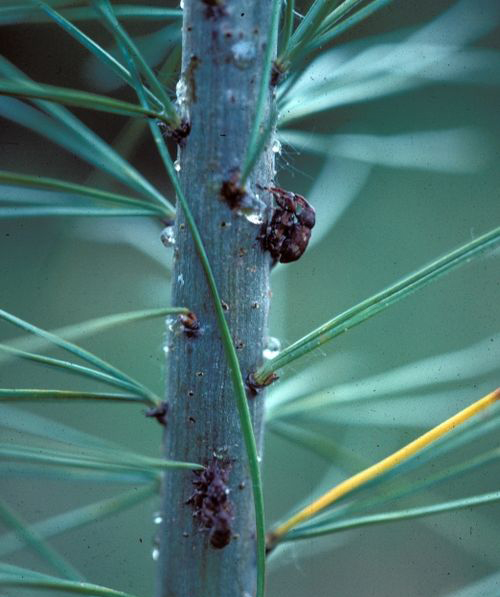Control white pine weevil in early spring
There is a brief window to manage white pine weevils with insecticides.

White pine weevil larvae kill the terminal leader and the top two to four years of growth on many varieties of spruce, as well as white and Scots pine trees. Damage from white pine weevil can be distinguished from other types of injury by the somewhat curled shape of the leader, sometimes referred to as a shepherd’s crook (Photo 1). The curling effect is caused by more weevil larvae feeding on one side of the leader. If you had weevil damage last year and need to control the weevils, do it early this spring.
The adult weevils overwinter on the ground, protected and insulated by the litter (fallen needles). Once they warm up, the weevils move up to the tops of the trees in late afternoon or early evening and feed on the terminal leader (Photo 2). Each time a female weevil makes a feeding wound on the terminal, she lays one to four eggs in the wound. Those eggs will hatch within a few weeks and the larvae chew their way through the bark. They will feed in the phloem under the bark for several weeks, pupate and then emerge as new adults around mid-summer.

Control by pruning
Except on very young trees, losing a terminal leader to white pine weevil will not cause the tree to die. It will delay growth and may add a crook or fork to the trunk and offer a slightly different appearance. Infested leaders can be pruned out before mid-July and burned to kill the insects within. After removing the leader, prune back all but one remaining side shoot by at least half their length. This will allow the remaining (unpruned) shoot to replace the infested leader that was removed.
Control by chemical application
If infestation is severe and you need to control white pine weevil with insecticides, your best opportunity is early in spring. Insecticide should be applied to the terminal leader once it begins to warm up, somewhere around 25 to 65 growing degree-days at a base temperature of 50 degrees Fahrenheit. In Michigan, this will occur between late March – mid April. It’s better to be a bit early than to be late with chemical control of white pine weevil. If you are unfamiliar with degree days, the article “Improve your garden with MSU Enviroweather’s tools and information” from Michigan State University Extension explains their relevance in predicting when pests or plant reach critical periods.
The goal of an insecticide application is to kill the adult females before they start laying eggs. Systemic insecticides such as those containing the active ingredient imidacloprid are effective on smaller landscape trees. Systemic insecticides are usually applied in late March or early April as a soil drench, which allows the product to be absorbed by the tree and reach the central leader.
Contact pyrethroid insecticides such as those containing the active ingredient bifenthrin, permethrin or cyfluthrin can also be sprayed on the upper trunk of spruce or pine with the option of a second application two weeks later. Apply these products at rates given on the label for bark beetles or borers. You may wish to choose a persistent product because the adult weevils don’t all emerge at the same time. Weevil adults could continue to appear from their overwintering sites for a period of three weeks or longer. Direct your spray to the leader (uppermost branch pushing upwards) and avoid spraying the rest of the tree to conserve beneficial species like predatory mites.
Another option is called Dimilin, an insect growth regulator with the active ingredient diflubenzuron. Dimilin is less harmful to pollinators and beneficial insects but is a restricted use pesticide that is only available to certified pesticide applicators. Michigan State University Extension always recommends reading the label of any chemical before applying it.
Reference to commercial products or trade names does not imply endorsement by MSU Extension or bias against those not mentioned.



 Print
Print Email
Email



